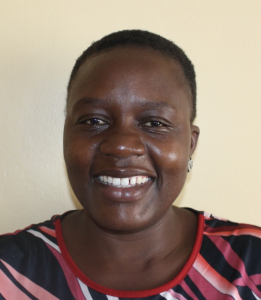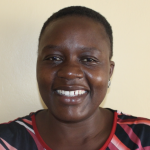"I have been in this school for the last 6 years and I must confess that a lack of safe water on the school compound has not been an easy thing for us," said Deputy Head Teacher of Sharambatsa Primary School, Mr. Jackson Wasilwa.
"We have a school feeding program and it's a great challenge to maintain as the water on the school compound cannot be used for it. This has seen our students waste a lot of time. Our performance has been average, mostly due to the lack of water."
On a typical school day for the 305 pupils who attend Sharambatsa Primary School, the morning starts as early as 6:00 am when they wake up, bathe, do their morning chores, eat breakfast, and even fetch water for their families' use first. Then, each student collects their school bag and a water container. As the pupils pass Mihako Spring, they rush to fetch water before arriving at school. At the school gate, students are checked for water and those found to be without it are sent back out to fetch water before they are allowed to join their morning assembly. Though the daily requirement to carry water seems like a punishment to the pupils alone, the 17 teachers and staff at Sharambatsa Primary are equally concerned about the pupils' health and well-being. Without a safe source of water on campus, their current situation just to meet the school's daily water needs are a lose-lose for everyone involved.
The school does have a hand-dug well on its grounds, but its water is not suitable for cooking and drinking. Though covered with a cement cap, the well is unlined below ground. This leaves the well water open to contamination from the surrounding area. Animal waste, human waste, and farm chemicals are just some of the things that leech into this water. These contaminants are compounded by the dirt and bacteria that enter the water when students must dip their entire container and the rope attached to it into the water to fetch it. The water is visibly murky.
The non-potable well water is supposed to be used for cleaning purposes only, but the youngest students sometimes drink it anyway not fully understanding the negative consequences; illnesses always follow. The poor quality well water forces the school to send students to the spring to collect water. Though this water is considered safe for consumption since the spring was protected, its the tiresome and time-consuming process that is dragging the pupils' health and academic performance down.
"I must give my comments regarding the state of water and sanitation in this school because I've been here long enough to know," said the school's Board of Management Chair, Mr. Peter Mulunda.
"The boys have only 1 latrine as the others collapsed. The girls have 6, but they are still not sufficient. Water has been a big issue. Each day I have to face parents...to explain to them why their children have to go to the spring each day. They blame me as the Chair for not ensuring that we have access to safe water like other schools...One day, one pupil was almost knocked down with a speeding motorist [while carrying water back to school]."
From humble beginnings in 1996 when it was founded by the African Israel Nineveh Church and learning began under a tree, Sharambatsa Primary has developed at a steady pace. Now with several permanent classrooms sponsored by the government, the school remains without a water source of their own and their latrine numbers are severely lacking for the size of their student body. With just 2 handwashing stations on campus placed near the staffroom, students are often too intimidated to use them, though there is not often the water or soap to make them functional anyway.
What We Can Do:
Rain Tank
A 75,000-liter rainwater catchment tank will help alleviate the water crisis at this school. The school will help collect the needed construction materials such as sand, bricks, rocks, and water for mixing cement. We will complement their materials by providing an expert team of artisans, tools, hardware, and the guttering system. Once finished, this tank will begin catching rainfall that will be used by the school’s students and staff for drinking, handwashing, cooking, cleaning, and much more.
We and the school strongly believe that all of these components will work together to improve standards at this school, which will help lead to better student academic performance and will help to unlock the potential for these students to live better, healthier lives.
Handwashing Stations
The student health club will oversee the 2 new handwashing stations we will provide, and make sure they are kept clean and in working condition. The club leaders will fill the handwashing stations with water daily and make sure they are always supplied with a cleaning agent such as soap or ash.
VIP Latrines
We will construct 2 triple-door latrine blocks using local materials that the school will help gather. 3 doors will serve the girls while the other 3 will serve the boys. All of these new latrines will have cement floors that are designed to be easy to use and to clean. And with a rain tank right on school property, there should be enough water to keep them clean.
Training on Health, Hygiene, COVID-19, and More
We will hold a 1-day intensive training session with students, teachers, and parents. This training will cover a wide range of topics including COVID-19 symptoms, transmission routes, and prevention; personal and environmental hygiene; and the operation and maintenance of the rain tank, latrines, and handwashing stations. There will be a special emphasis on handwashing.
Our team of facilitators will use a variety of methods to train, including participatory hygiene and sanitation transformation, and asset-based community development. We will initiate a student health club, which will prepare students to lead other pupils into healthy habits at school and at home. We will also lead lectures, group discussions, and provide illustrative handouts to teach health topics and ways to promote good hygiene practices within the school including handwashing and water treatment. We will then conduct a series of follow-up trainings before transitioning to our regularly scheduled support visits throughout the year.

 Rainwater Catchment
Rainwater Catchment
 Rehabilitation Project
Rehabilitation Project














 We installed new latrines and handwashing stations for students, and we trained the school on improved sanitation and hygiene practices, including COVID-19 prevention. These components will unlock the opportunity for these students to live better, healthier lives.
We installed new latrines and handwashing stations for students, and we trained the school on improved sanitation and hygiene practices, including COVID-19 prevention. These components will unlock the opportunity for these students to live better, healthier lives.



 In front of the access area, we constructed a soak pit where spilled water can drain from the access area through the ground. The pit helps to keep the tap area dry and tidy.
In front of the access area, we constructed a soak pit where spilled water can drain from the access area through the ground. The pit helps to keep the tap area dry and tidy.


















